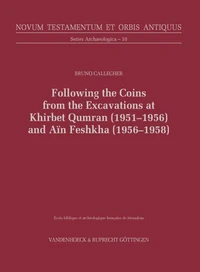Coins and Economy in Magdala/Taricheae
Par : , , , ,Formats :
Disponible dans votre compte client Decitre ou Furet du Nord dès validation de votre commande. Le format PDF est :
- Compatible avec une lecture sur My Vivlio (smartphone, tablette, ordinateur)
- Compatible avec une lecture sur liseuses Vivlio
- Pour les liseuses autres que Vivlio, vous devez utiliser le logiciel Adobe Digital Edition. Non compatible avec la lecture sur les liseuses Kindle, Remarkable et Sony
 , qui est-ce ?
, qui est-ce ?Notre partenaire de plateforme de lecture numérique où vous retrouverez l'ensemble de vos ebooks gratuitement
Pour en savoir plus sur nos ebooks, consultez notre aide en ligne ici
- Nombre de pages405
- FormatPDF
- ISBN978-3-647-50193-2
- EAN9783647501932
- Date de parution14/08/2023
- Protection num.pas de protection
- Taille196 Mo
- Infos supplémentairespdf
- ÉditeurVandenhoeck & Ruprecht
Résumé
On a monetary basis, Magdala must be considered as one of the most important and active settlements between the 1st century BC and most of the 3rd century AD on Lake Kinneret, a place of production and trade, of supply for military forces, certainly in contact with other trading centres, probably located on the Mediterranean coast, however in a 'market' perspective quite different from our current experience and even from the semantic content of this word, often abused with a semantic extension that does not correspond to the experience of the ancients.
Its monetary decline started on the early 4th century, when the economic and monetary strategies of the Constantinian era shifted the flow of money to other routes, especially between the great port cities of the Mediterranean. The welcome contribution of Callegher's study derives from the new data published, which allows us to overcome "clichés" and a stereotypical view of both the archaeological site and the economy of the Upper Galilee.
Its monetary decline started on the early 4th century, when the economic and monetary strategies of the Constantinian era shifted the flow of money to other routes, especially between the great port cities of the Mediterranean. The welcome contribution of Callegher's study derives from the new data published, which allows us to overcome "clichés" and a stereotypical view of both the archaeological site and the economy of the Upper Galilee.
On a monetary basis, Magdala must be considered as one of the most important and active settlements between the 1st century BC and most of the 3rd century AD on Lake Kinneret, a place of production and trade, of supply for military forces, certainly in contact with other trading centres, probably located on the Mediterranean coast, however in a 'market' perspective quite different from our current experience and even from the semantic content of this word, often abused with a semantic extension that does not correspond to the experience of the ancients.
Its monetary decline started on the early 4th century, when the economic and monetary strategies of the Constantinian era shifted the flow of money to other routes, especially between the great port cities of the Mediterranean. The welcome contribution of Callegher's study derives from the new data published, which allows us to overcome "clichés" and a stereotypical view of both the archaeological site and the economy of the Upper Galilee.
Its monetary decline started on the early 4th century, when the economic and monetary strategies of the Constantinian era shifted the flow of money to other routes, especially between the great port cities of the Mediterranean. The welcome contribution of Callegher's study derives from the new data published, which allows us to overcome "clichés" and a stereotypical view of both the archaeological site and the economy of the Upper Galilee.


